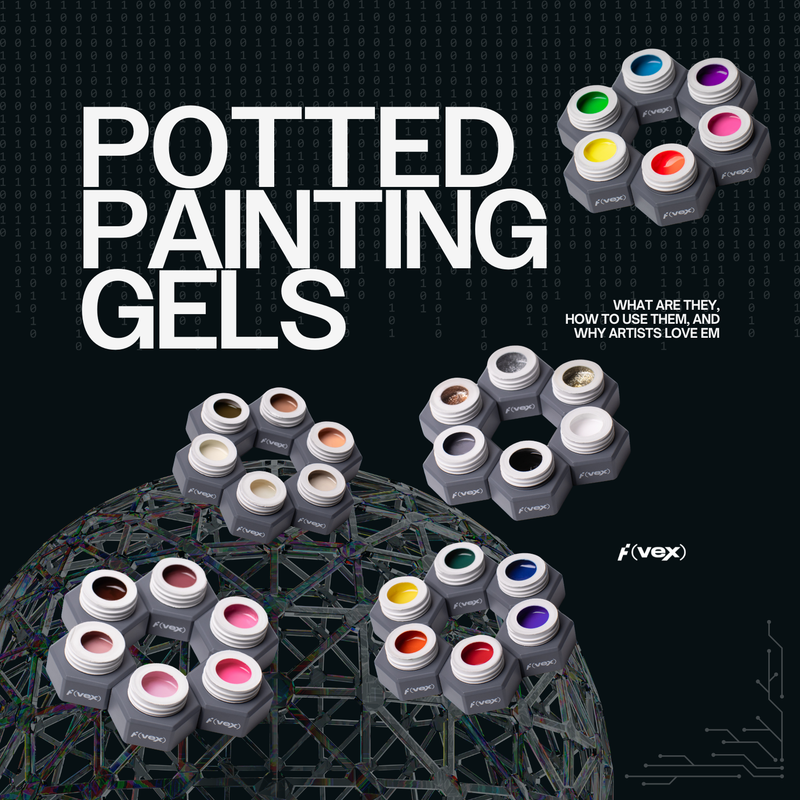So, you juuust finished your boldest red design yet.
You’re vibing.
You’re obsessed.
You’re already picturing the IG post. And then, two days later, it’s giving… musty sunset? Dull ketchup? Full-blown yellow?
What gives?
Let’s break down what’s actually happening with red pigments, why this issue is so common (especially with pressed pigments), and how to stop it from wrecking your next look.
Why Do Red Pigments Fade or Turn Yellow? Let’s Talk About It!
This is one of the top questions we get from both the nail pros and the at-home DIY girlies. And no... it’s not your topcoat’s fault. Not ours, not anyone’s. The answer is deeper than that. Literally.
Pressed pigments, especially reds and pinks, are some of the most reactive shades in the nail world. They’re gorgeous, but sensitive... kinda like that one bestie who needs to be protected at all costs. And when something goes awry (👀 sun, sweat, skincare 👀) red pigments are the first to show it.
The Real Reasons Red Pressed Pigments Can Shift Color

Here’s the science, minus the snooozefest.
☀️ UV Exposure & Sunlight
Red pigments, especially organic red pigments, can degrade under UV light.
Think... natural sunlight, tanning beds, or even overexposure during your curing process.
Even if you’re sealing with a glossy topcoat, UV rays can still sneak in and start oxidizing the pigment, shifting that fiery red into a rusty yellow-orange.
🔥 Heat & Humidity
Ever noticed faster fading after a steamy shower or a ravenous kitchen sesh with all burners going?
Heat and humidity speed up oxidation. That includes daily exposure like hot water, steam, and general sweaty-girl summer vibes.
💦 Skincare, Perfumes, Hand Sanitizers
We're gonna hold your hand when we tell you this but... your favorite hand cream might be secretly sabotaging your set.
Ingredients like avobenzone (in sunscreen), alcohol (in sanitizers), or fragrance oils can mess with the pigment’s chemical makeup and cause yellowing. Even perfumes and lotions count.
💡 Undercured Topcoat
If your topcoat isn’t fully cured, the surface stays slightly reactive. This opens the door to pigment oxidation.
Low-wattage lamps (especially those 24–36W ones floating around Amazon) might not be cutting it. And if you’re rushing the cure time? You’re not giving the formula a chance to lock in properly.
🧴 Oil Absorption in Matte Topcoats
Matte topcoats are slightly porous, which is what gives them that soft, touchable finish. But it also means they can soak up oils from your skin or the environment. Over time, those oils tint the pigment and leave it looking off.
✋ Friction & Wear
Fumbling with tight jeans, hauling groceries, or washing your hands like a surgeon on Grey’s Anatomy... all those little micro-rubs can add up fast.
If your pigment isn’t fully sealed (or if your topcoat’s starting to wear down), that constant contact can slowly grind away at your design.
Is Yellowing a Product Defect?
Short answer: Nope.
Pressed red pigments, especially organic ones, are more prone to oxidation. Why? Because they're formulated with cosmetic-grade, organic ingredients that are safer for your skin and less likely to trigger irritation or allergies.
We know because, that's what we're all about.
We don’t mess around with harsh synthetic reds just to make a pigment last longer. That’s the tradeoff. You’re getting cleaner, more breathable formulations that feel better on your body, but they need a little more protection from the elements.
And honestly? We’ll take that any day over using sketchy ingredients that cling to your nails faster than dog hair on your freshly washed black jeans.
That's also why we nerd the hell out over our testing and formulations. We’ve clinically tested both our matte and glossy topcoats. Our findings? They’re UV-stable-AF.
So, if you’re noticing yellowing, it's usually not the topcoats fault. It’s more likely everything else that's happening around your nails.
How to Prevent Red Pigments from Yellowing or Fading
Alright, alright, alright. So what can you actually do about it?
Here’s your fiery-red-approved checklist:
-
Limit UV exposure
Avoid direct sunlight right after application. Skip the tanning bed. Keep your hands out of your sunroof like you’re in a summer-coming-of-age film (as tempting as that may be), at least until your pigment’s sealed tight.
-
Be mindful with skincare
If you're using SPF, lotion, or perfume, apply it before you do your nails—not after. Already wearing a set? Wash your hands before applying anything greasy to avoid that product buildup sitting on top of your pigment.
Bonus tip: oil-free hand creams are your bestie if you're tryna keep things fresh longer. You can also rock the 'don't mind me, just rubbing the back of my hands together' method to only get the cream exactly where you want it—shoutout to the sensory overload girlies on that one.
-
Watch out for harsh chemicals
Cleaning the bathroom? Wear gloves. Hitting the pool? Rinse off after. Anything with bleach, chlorine, or alcohol can mess with pigments over time.
-
Use a proper lamp
Aim for 48W or higher with dual wavelength (365+405nm). If you’re using a lower wattage lamp, bump up your cure time to 120–180 seconds.
-
Seal your work twice
Adding a second thin layer of glossy topcoat = extra armor for your art.
-
Don’t touch the pigment pre-seal
Pressed pigments need to be fully sealed in. If you rub or brush too much before topcoat, you’re breaking it down before it even gets a chance to slay.
What to Do If Your Red Pressed Design Starts to Yellow
You’re mid-wear and something’s off. Here’s the fix:
-
Lightly buff the surface
Just a gentle scuff to refresh the finish and remove any surface residue.
-
Clean with isopropyl alcohol
Sometimes yellowing is just surface buildup, not actual pigment fade.
-
Add a thin layer of glossy topcoat
Locks everything back in, gives it some shine, and can sometimes bring the original color back to life. Our Hi-Def Glossy Topcoat is perfect for this! UV-stable, super smooth, and built to refresh a faded design without starting over.
-
Check your process
Evaluate everything! Lamp strength, exposure time, products used, application steps. Adjust accordingly and try again.
Final Thoughts: You’re Not Doing Anything Wrong
Yellowing is science, not sabotage.
It’s not because you picked the wrong brand. It’s not because your topcoat failed you. It’s just how organic pigments react to the world around them.
The good news? Now you know what to watch out for! Put these tips to work, and your reds won’t just last... they’ll keep turning heads, flipping off fading, and showing up LOUD the way they were meant to.
Want to make sure your pigment stays put?
Our topcoat collection was built to block the bullsh*t. UV-tested, wear-tested, and ride-or-die for your designs.
FAQ Time: Red Pressed Pigments
Why does red nail polish turn yellow?
Usually due to UV exposure, heat, chemical interactions, or oil absorption into the topcoat. Red pigments, especially organic ones, are just a littttle more high-maintenance, because they know they're worth it.
Does nail polish yellow over time?
It can! Especially red or pink pressed pigments, and especially if exposed to light or environmental factors. It’s chemistry, not a product fail.
How do I stop red pigment fading?
Use UV-stable topcoats, cure them fully, avoid chemical exposure, and double seal your pigment. Small steps = longer wear.
Can I fix yellowed nail art?
Pft, we've always got the secret sauce! Try buffing, cleaning with alcohol, and reapplying topcoat to restore the look. It won’t always be a total reset, but it can seriously revive the vibe.



